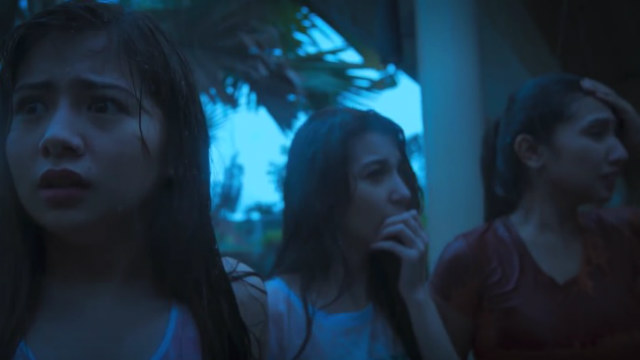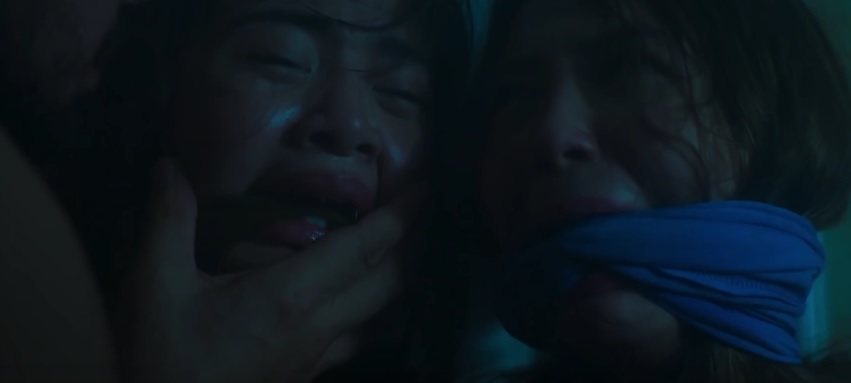
Richard Somes’ Cry No Fear opens very much like a film intended to titillate male viewers.
Accompanied by the most boisterous of musical scores, the camera vigorously lingers on the exposed curves of a skimpily-clad Kaycee (Donnalyn Bartolome), who has just woken up from slumber.
Outside, her half-sister Wendy (Ella Cruz) is disrobing down to her bikini. She stretches her arms, then takes a plunge, with the camera similarly delighting in baring her luxurious morning ritual.
Worlds apart
The near-lascivious introductions of the two ladies seem worlds apart to the bloody messes that they become in the film’s parting shot.
What happens in between comprise what the film deems as entertainment.
The half-sisters, who we later learn loathe each other, are left alone with their nanny (Sheree Bautista) while their father (Lito Pimentel), a once-famous actor struggling to find roles to play, is away for a shoot. There is also a typhoon and as cautioned by the news anchors, there are bad elements abound who are all too willing to take advantage of the horrid weather to commit crimes.
Of course, this is exactly what happens. A family of bandits led by a married couple (Lander Vera-Perez & and Patricia Javier) makes their way to the two sisters’ house and wreaks havoc.
Cry No Fear’s plot, while trite, has been tested. The home invasion storyline has been exploited for tension-laden thrills for decades, with prominent directors like Roman Polanski (1966’s Cul-de-Sac), Sam Peckinpah (1971’s Straw Dogs), David Fincher (2002’s Panic Room), and Michael Haneke (1997’s Funny Games and its 2008 English-language remake) all joining the fray.
The examples as of late have become more visceral in their depictions of psychological, physical and even sexual torture, and Somes seems to be taking his cue from the increase in the intensity.

Tame in comparison
Cry No Fear, however, is still quite tame in comparison.
Sure, there is more violence here than is typical in a local film. The film’s type of violence is also more realistically drawn. Yet, it still feels that the film teeters towards safety. It avoids ruffling feathers, portraying a type of home invasion that is thin when it comes to allusions and insinuations. It does confront class struggles, but its comprehension is frustratingly simplistic. While the screenplay attempts to be creative in characterizing its invaders as capable of some good manners and civility, the effect is more humorous than humanizing.
It isn’t just that Cry No Fear is stubbornly unsophisticated. It is also technically confused.
Somes, a very capable production designer, seems to have overdone the look of his film. His invaders look more like a motley crew of theater students still in costume than amoral knaves. The costumes, composed of distressed military jackets and bandanas, are far too extravagantly styled, far too specific to their ill motives, to be believable.
On the other hand, the house, that is the primary setting of all the threats, lacks the requisite design to make all the tricks of the film work. Somes neglects mapping the nooks and crannies, relying on the mostly sloppily lighted footage to dictate the efficacy of the horror he attempts to achieve.

Without rhyme or reason
Without a rhyme or reason to its desire to inflict so much torture towards its terrorized protagonists, what’s left of Cry No Fear is just its impression of women either as objects to ogle at or likely victims of oppression.
While the sisters do retaliate, their actions are fueled by a need to survive rather than a desire to strip themselves of the dirt and grime inflicted by both the men who harm them and the men who initially viewed them as sexually desirable items.
More haughty than high-concept, the film simply fails to sustain any of the tension it imagines itself to have. – Rappler.com

Francis Joseph Cruz litigates for a living and writes about cinema for fun. The first Filipino movie he saw in the theaters was Carlo J. Caparas' Tirad Pass.
Since then, he's been on a mission to find better memories with Philippine cinema.







